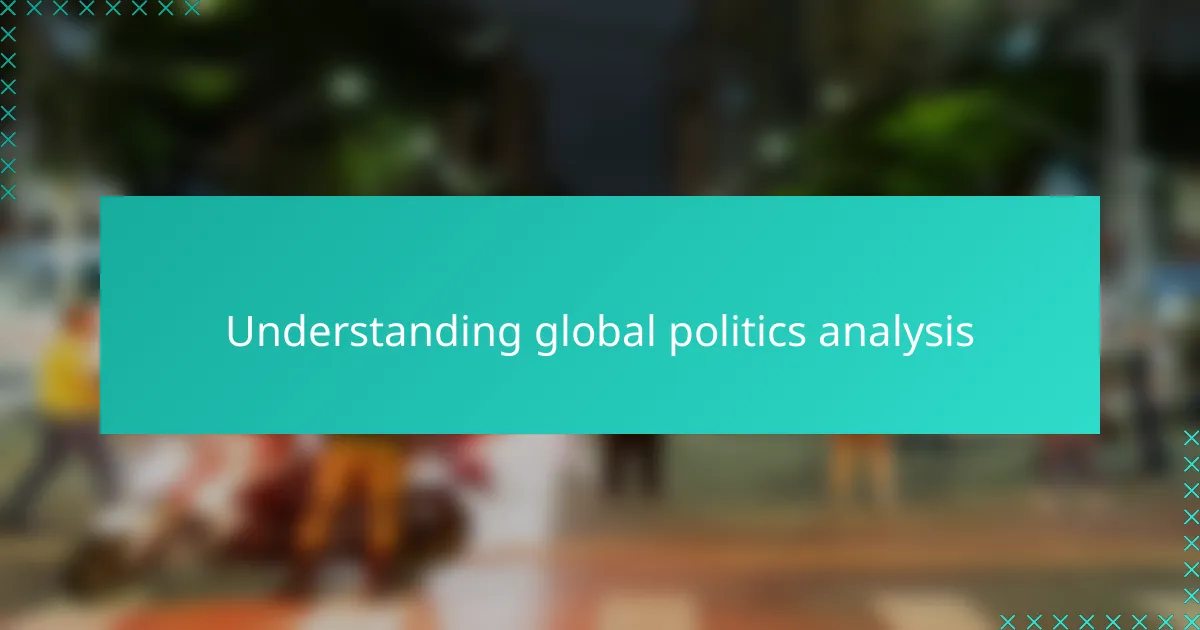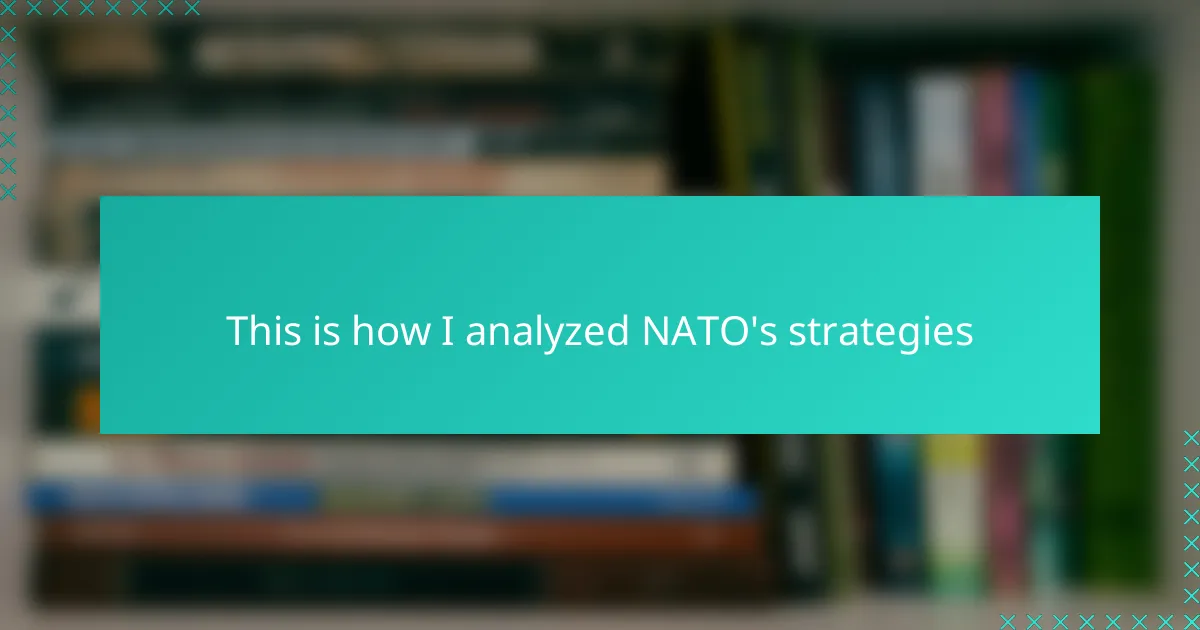Key takeaways
- Understanding global politics involves recognizing patterns, motivations, and emotional layers behind decisions, moving beyond mere facts.
- NATO serves as both a military alliance and a diplomatic entity, adapting its strategies in response to evolving geopolitical realities and a diverse membership.
- Key analytical tools include SWOT analysis, scenario planning, and data visualization, which enhance clarity and depth in understanding NATO’s strategies.
- The importance of perception and diplomacy in NATO’s operations highlights the necessity of adaptability and relationships in maintaining cohesion among member states.

Understanding global politics analysis
When I first dived into global politics analysis, I remember feeling overwhelmed by the sheer volume of information and conflicting narratives. How do you sift through biases to find what truly matters? Over time, I realized that understanding global politics isn’t just about memorizing facts—it’s about recognizing patterns and motivations behind every action.
In my experience, analyzing global politics requires a blend of patience and curiosity. I often ask myself: What drives a country’s decisions on the world stage? This kind of questioning helped me move beyond surface-level news and uncover the deeper strategic intentions that shape international relations.
I’ve also come to appreciate the emotional layers behind political moves—fear, ambition, trust, and sometimes sheer desperation. Recognizing these human elements made my analysis more nuanced and, honestly, more engaging. After all, global politics is ultimately about people, their choices, and how those choices impact us all.

Defining NATO and its role
NATO, or the North Atlantic Treaty Organization, has always struck me as more than just a military alliance. It’s a collective commitment where member countries vow to defend one another—a principle that, in my view, reflects a profound sense of shared responsibility and trust. When I first learned about Article 5, which states that an attack on one is an attack on all, I questioned how such a promise holds up in today’s complex world.
Reflecting on NATO’s role, I realize it’s not only about defense but also about fostering political unity among diverse nations. From my perspective, this blend of military readiness and diplomatic collaboration makes NATO a unique actor in global politics. I often wonder how this balance influences the alliance’s strategic choices in times of crisis.
Understanding NATO also means seeing it as a reflection of evolving geopolitical realities. Over the years, I’ve noticed how its mission and strategies have adapted—from countering the Soviet threat to addressing terrorism and cyber warfare. This adaptability, to me, highlights NATO’s enduring relevance and the challenges it faces in maintaining cohesion amid changing threats.

Key strategies NATO employs
One key strategy NATO employs is deterrence—something that caught my attention early on. It’s not just about having forces ready; it’s about sending a clear message to potential adversaries that aggression will meet a unified, robust response. I often think about how this calculated stance helps maintain a precarious peace, relying as much on perception as on actual military might.
Then there’s the alliance’s emphasis on collective defense, which I find fascinating because it’s both a practical and deeply symbolic commitment. The idea that an attack on one member triggers support from all creates a powerful network of security, but it also demands constant coordination and trust. Have you ever wondered how such diverse countries maintain that level of cohesion? From what I’ve seen, it’s a careful mix of shared values and relentless diplomacy.
Lastly, NATO’s focus on adaptability really stands out when I consider how the world’s threats are evolving. The alliance continually updates its strategies to address cyber attacks, terrorism, and hybrid warfare—areas that weren’t on the radar when NATO was founded. This willingness to evolve, in my view, is what prevents NATO from becoming obsolete and keeps it effective in protecting its members.

Methods for analyzing NATO strategies
When I approach analyzing NATO’s strategies, I start by dissecting official documents and communiqués. These texts reveal not only what NATO plans but also hint at the underlying priorities and concerns driving those plans. Have you ever noticed how the choice of words in these statements can signal subtle shifts in focus or intent? From my experience, reading between the lines is just as important as the text itself.
Another method I find invaluable is examining the geopolitical context surrounding NATO’s moves. By looking at current events, regional tensions, and global power dynamics, I try to understand why certain strategies emerge when they do. It’s like piecing together a puzzle where every country’s interests and fears influence the bigger picture. This approach helped me grasp why NATO adapts its strategies in response to evolving threats rather than sticking to a rigid playbook.
Lastly, I pay close attention to how member states interact within the alliance—through public debates, joint exercises, and diplomatic signals. These interactions reveal the alliance’s cohesion level and expose internal challenges or consensus. Observing these dynamics made me realize that NATO’s strength lies as much in its ability to manage differences as in its military capabilities. Isn’t it fascinating how cooperation shapes strategy just as much as confrontation does?

Tools used in strategic analysis
When I first started using tools to analyze NATO’s strategies, I quickly learned that frameworks like SWOT (Strengths, Weaknesses, Opportunities, Threats) are essential. They helped me break down complex information into manageable pieces, allowing me to see where NATO stands strong and where vulnerabilities might lie. Have you ever tried mapping out those factors yourself? It’s surprising how much clarity emerges from such a simple exercise.
I also rely heavily on scenario analysis, which, from my experience, brings depth to understanding NATO’s possible reactions under different global events. Imagining various future scenarios forces me to think beyond current realities and consider how unpredictable factors might influence NATO’s decisions. It’s a bit like playing chess, anticipating moves several steps ahead—a strategy enthusiast’s dream, really.
Lastly, data visualization tools became game changers in my work. They transform raw data—like troop deployments or budget allocations—into clear charts and maps, making patterns visible at a glance. I remember a moment when a heat map of NATO’s military presence instantly revealed strategic priorities I hadn’t noticed before. Doesn’t seeing information this way make analysis not just easier but also more thrilling?

Case study of NATO strategy analysis
Diving into a case study of NATO’s strategy analysis, I focused on unpacking specific operations that exemplify its adaptive approach. One moment that stood out was observing NATO’s response to the evolving security situation in Eastern Europe—how they balanced deterrence with diplomatic engagement. It felt like watching a high-stakes chess game where every move is calculated but also influenced by ever-shifting political pressures.
What fascinated me most was how NATO’s strategies are not monolithic. For example, in one instance, the alliance rapidly adjusted its troop deployments and communication tactics in response to unexpected provocations. From my perspective, this fluidity reveals the real-time challenges NATO faces in aligning the interests of diverse member states under a unified strategy.
I also noticed the subtle art of signaling embedded in their strategic choices. The deliberate timing and messaging behind joint military exercises or public statements often carry more weight than the physical actions themselves. Have you ever thought about how much of strategy relies on perception? For me, this interplay between action and image underscored how NATO operates not just on the battlefield, but in the arena of global opinion and influence.

Lessons learned from the analysis
One lesson that became clear to me is how essential adaptability is for NATO’s continued relevance. Watching the alliance shift focus from traditional military threats to hybrid and cyber warfare made me realize that rigidity in strategy simply doesn’t work in today’s fast-changing world. Have you ever witnessed an organization stuck in old ways? NATO’s ability to evolve reminded me why flexibility is a key strength in global politics.
I also learned that behind NATO’s public posture lies a complex dance of diplomacy and trust among member states. It struck me how fragile yet resilient this balance is—every country’s interests must be constantly negotiated to maintain cohesion. This made me appreciate the human element in grand strategies; it’s not just about hardware and forces, but relationships and shared values that truly hold the alliance together.
Lastly, my analysis taught me the power of perception in warfare and diplomacy. NATO’s strategic signaling—through timed military exercises or carefully worded communiqués—often carries more weight than the physical actions themselves. It’s fascinating how much the image of unity and strength can deter aggression, showing me that in global politics, what you convey can be as impactful as what you do.
